As requested by the Joint Legislative Audit Committee, we evaluated the community corrections program administered by the Department of Corrections (DOC). DOC is statutorily responsible for supervising individuals who were convicted of crimes and reside in the community. The parole and probation agents who supervise these individuals work in eight DOC regions throughout the state. Program expenditures increased from $222.5 million in fiscal year (FY) 2018-19 to $233.1 million in FY 2021-22 (4.8 percent).
To help complete this audit, we visited 22 DOC field offices throughout the state, interviewed 76 DOC agents and their supervisors, and observed 54 interactions between agents and individuals under supervision. We also surveyed 1,086 agents (59.9 percent of whom responded), all 72 county sheriffs (56.9 percent of whom responded), and a random sample of 5,000 individuals who were under supervision in December 2021 (4.6 percent of whom responded).
Individuals under community supervision included those on probation, extended supervision, and parole, including sex offenders. The number of individuals decreased from 67,203 in February 2020, which was one month before the public health emergency began, to 63,204 in December 2021. Most individuals who responded to our survey indicated that their DOC agents treated them fairly and with respect.
When an individual enters community supervision and then periodically during supervision, DOC typically completes risk and needs assessments that indicate the likelihood an individual will engage in future criminal activity and an individual’s need for program services. The assessment results also help to determine an individual’s supervision level in the community. Approximately one-half of DOC agents who responded to our survey indicated that the assessments are effective overall and establish an appropriate risk level for individuals.
We found that 25,687 initial risk and needs assessments (35.8 percent) were not completed in a timely manner for individuals who began supervision from January 2019 through December 2021, including 13,270 assessments (18.5 percent) that were not completed within 60 days after the individuals began community supervision. We recommend DOC ensure such assessments are consistently completed in a timely manner.

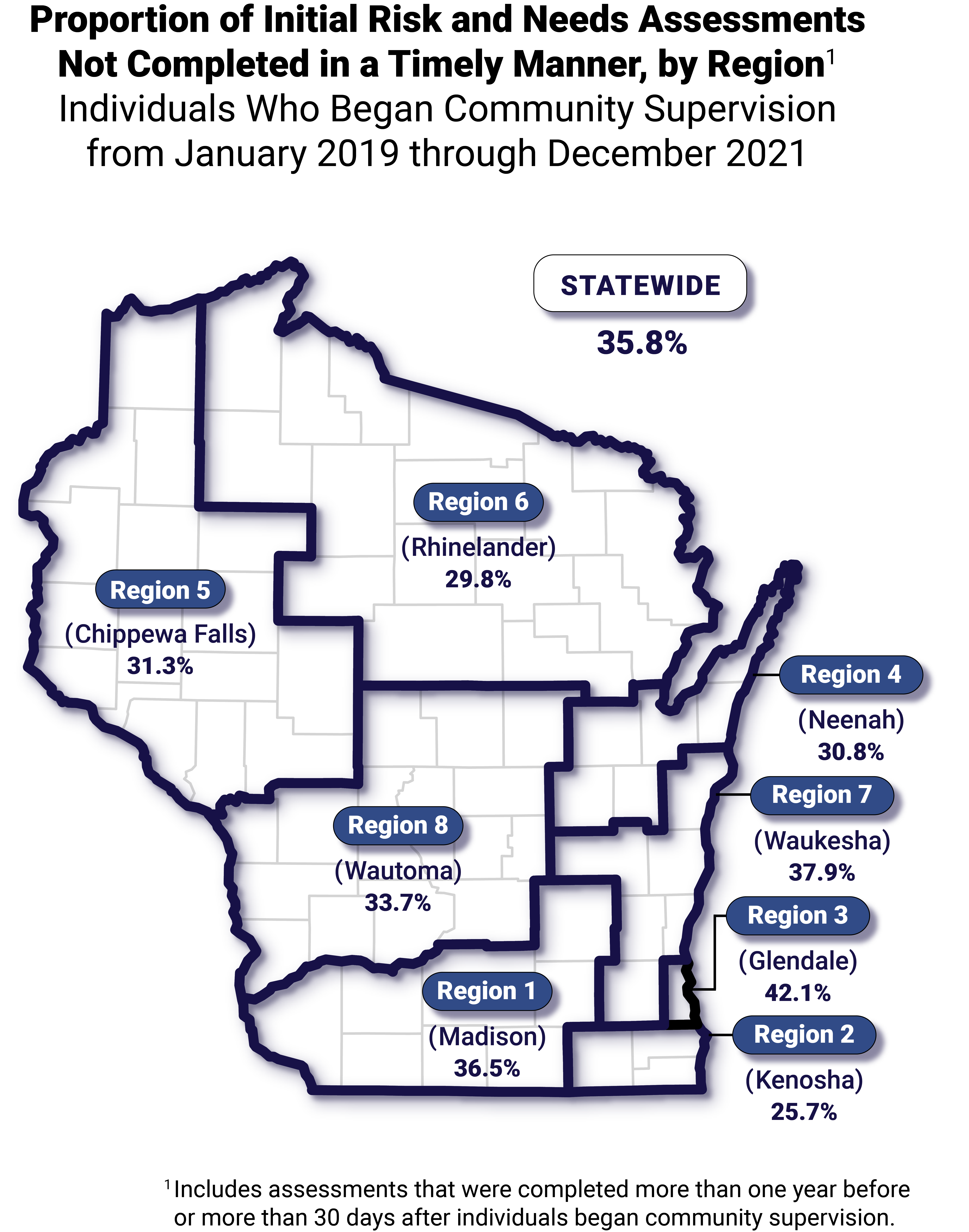
We also found that considerable differences existed among the eight regions in the extent to which initial risk and needs assessments were not completed in a timely manner, and in the extent to which agents overrode the supervision levels indicated by the assessments.
Statutes require DOC to provide individuals under community supervision with program services that are intended to increase public safety and reduce the risk of recidivism. Common program services include housing, cognitive behavioral, and alcohol and other drug abuse (AODA) services. Program services can be provided by DOC or entities with which DOC contracts. Services can be paid for by DOC, insurance firms, or others.
From January 2019 through December 2021, 19.6 percent of the 128,213 individuals received program services paid for or provided by DOC; individuals successfully completed 45.4 percent of services; and the proportions of individuals who received such services and who completed such services varied considerably among the eight regions.
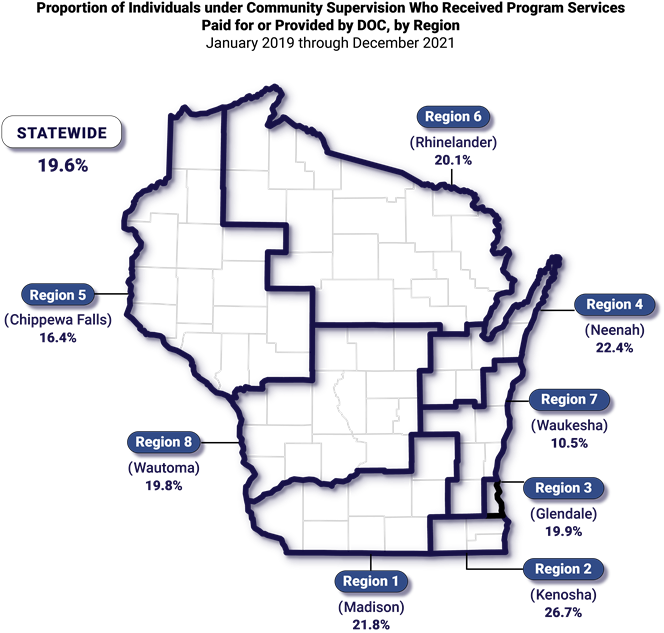
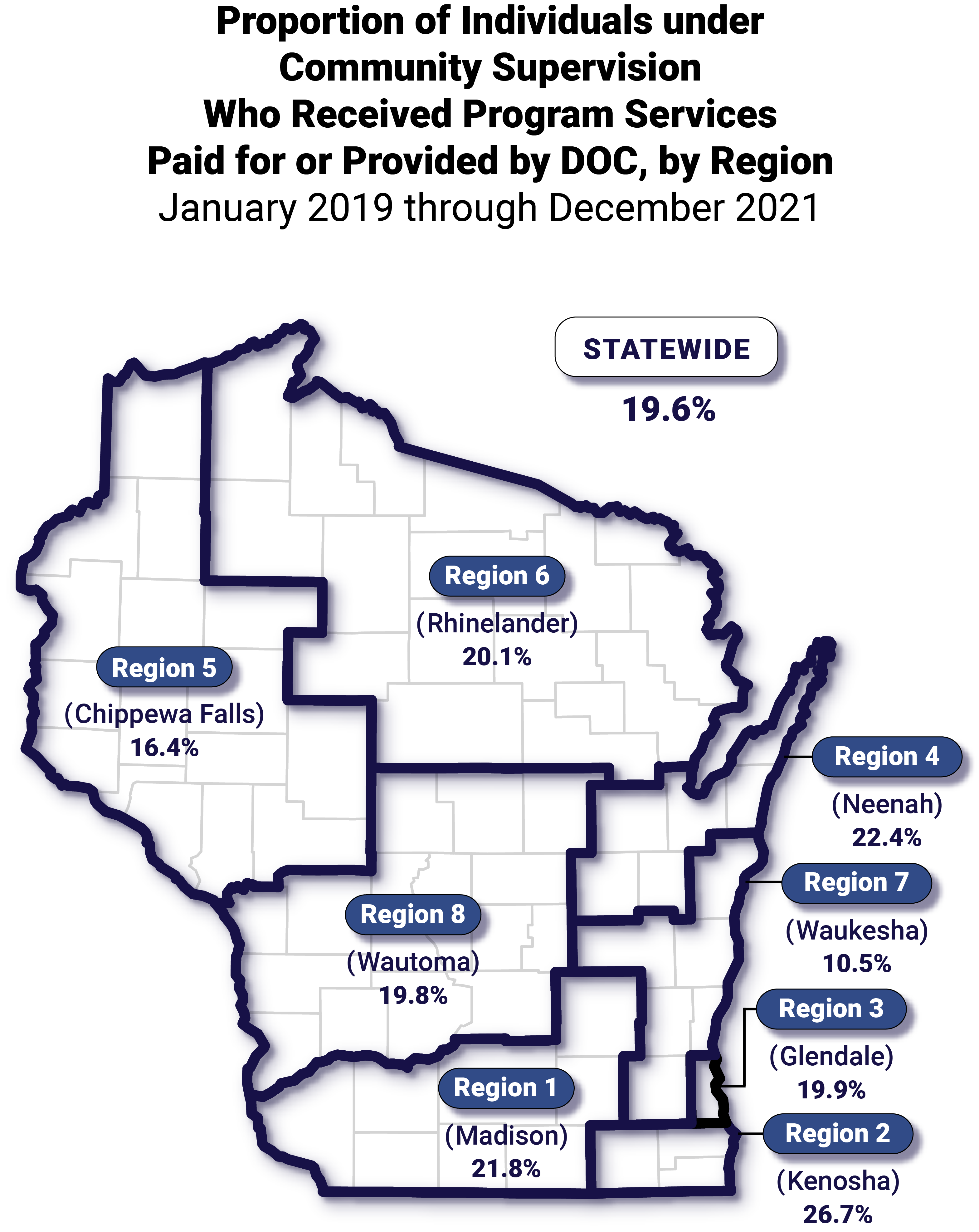
Although DOC centrally tracks program services it pays for or provides, DOC does not centrally track other program services, even if courts have ordered that individuals complete them. We recommend DOC collect non-confidential data on all court-ordered services provided to individuals and develop a plan for complying with statutes by evaluating the effectiveness of program services at decreasing the rates of arrest, conviction, and imprisonment.
Policies require DOC agents to investigate allegations that individuals under community supervision violated the rules of supervision. Noncriminal violations of program rules accounted for more than one-half of all violations and included 102,519 violations for using drugs or alcohol. We found considerable differences among the eight regions in the extent to which agents completed investigations of individuals from January 2019 through December 2021. In 2021, 12.4 percent of investigation reports took longer to complete than the 10 days required by policies. We recommend DOC ensure investigation reports are consistently completed within 10 days.
From January 2019 through March 2022, 168,066 consequences were imposed on individuals. After completing investigations, DOC agents determine the consequences for individuals under community supervision who violated laws, court-ordered rules, or program rules. Consequences range from verbal warnings to jail time or revocation of community placement.
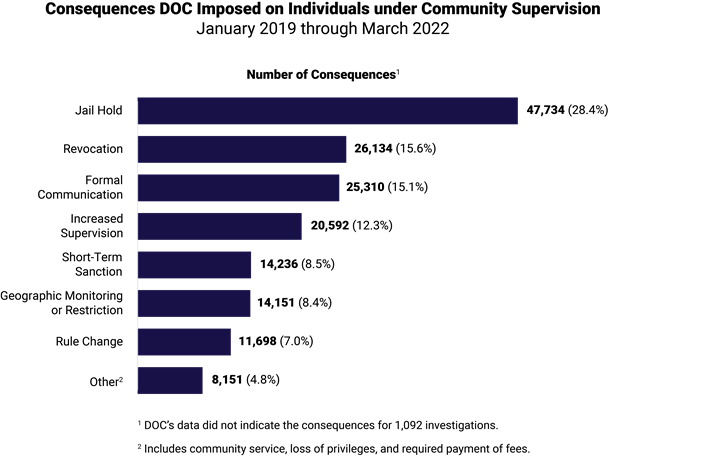
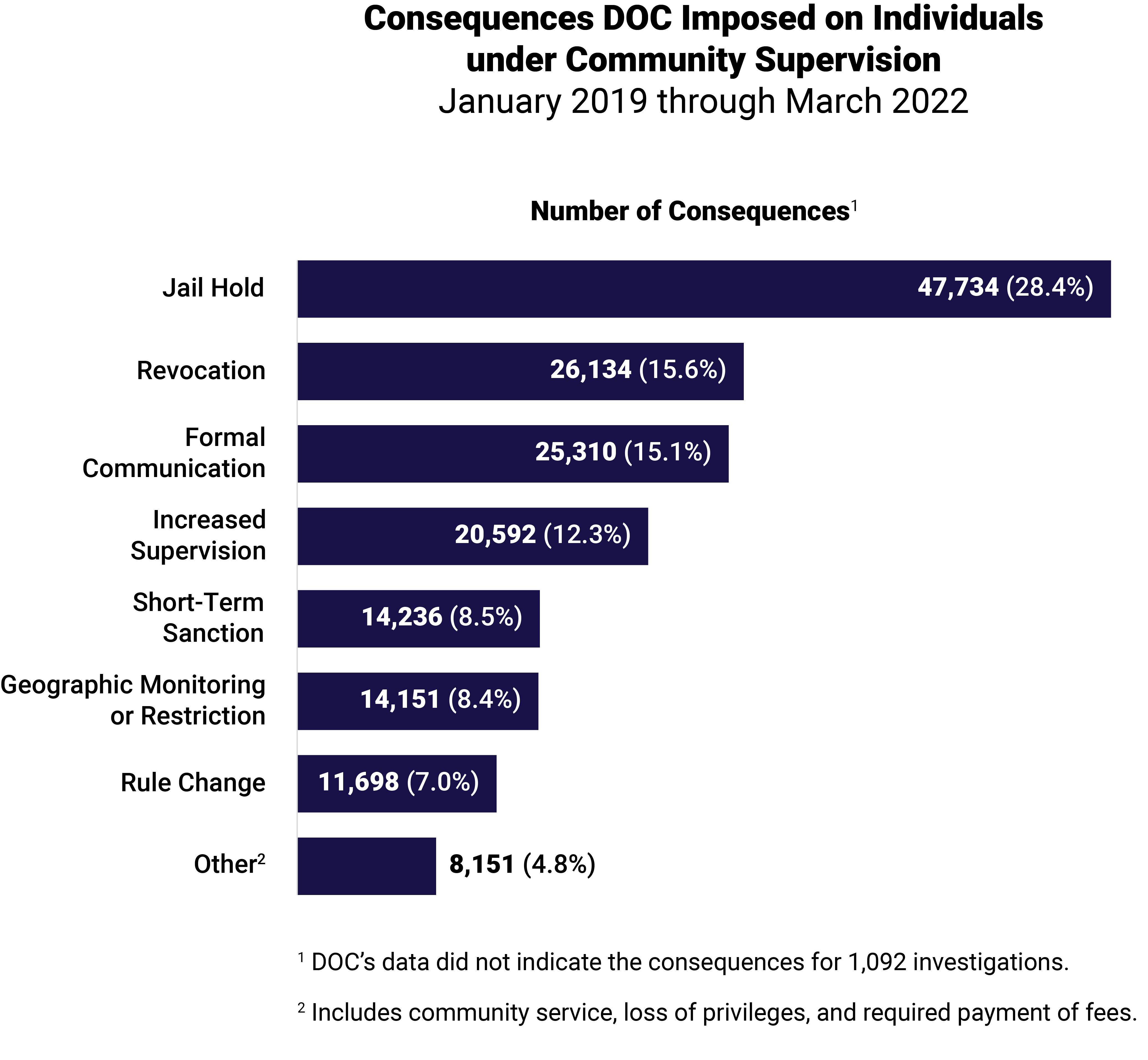
Policies include a framework that recommends consequence levels based on an individual’s risk level and a violation’s severity level, but they allow these levels to be overridden if agents specify aggravating or mitigating factors. We found that DOC agents did not specify such factors in 20.2 percent of the 48,493 investigations that resulted in overrides. We also found considerable differences among the eight regions in the extent to which overrides occurred and when selected consequences were imposed.
Many DOC agents who responded to our survey indicated dissatisfaction with how consequences are determined, including 75.1 percent of responding agents who indicated the violation consequences required by policies were too lenient after January 2021.
Statutes require DOC to review the consequences it imposed in order to assess differences among consequences, evaluate the effectiveness of consequences, and monitor the effect of consequences on the number of revocations. Because DOC did not comprehensively comply with this statutory requirement, we recommend DOC develop a multi-year plan for reviewing consequences it imposed.
From July 2019 to July 2022, the number of authorized full-time equivalent (FTE) staff positions that administered the program increased from 1,890.6 to 1,968.6 (4.1 percent). The proportion of DOC agents employed in permanent positions for at least one year decreased in recent years. Most agents who responded to our survey indicated that they were dissatisfied with their wages and workloads, but most responding agents believed they were able to help the individuals they supervise and help to maintain public safety.
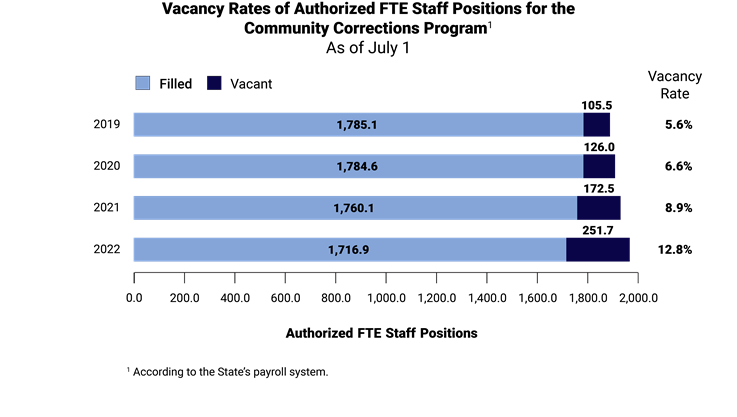
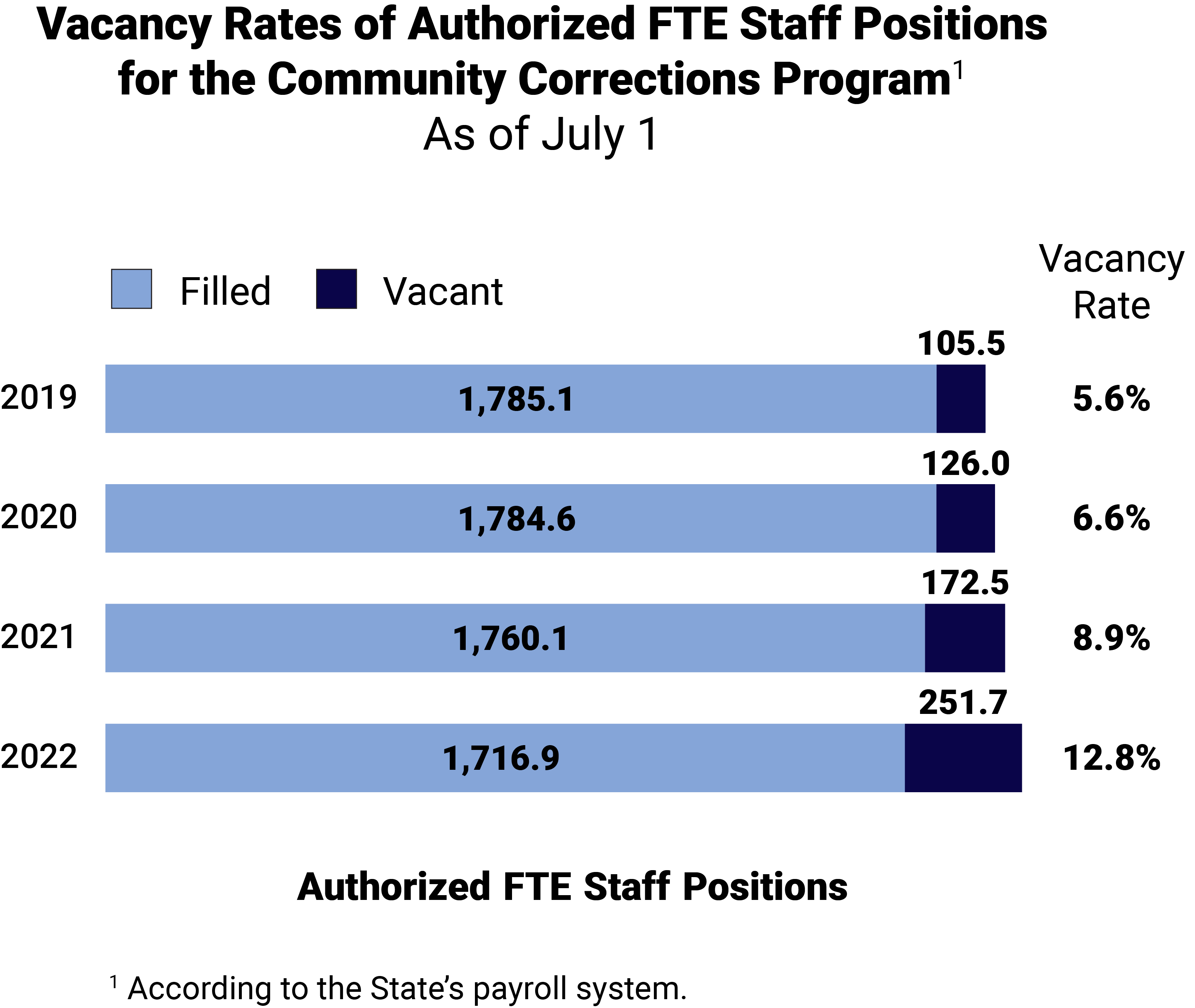
DOC should examine programmatic differences among the eight regions, as well as among the races and ages of individuals under community supervision. If DOC determines that some of these differences indicate individuals may not have been supervised appropriately, it should develop and implement a plan to address the differences and ensure that individuals are supervised appropriately.
DOC has implemented an evidence-based response to violations project that is intended to improve how it responds to violations committed by individuals under community supervision. In order to comprehensively evaluate whether the project has been successful, the project needs to have been in operation for a sufficient period of time, and a sufficient amount of data needs to be available. At the time of our audit, the January 2021 policy changes that DOC made to implement the project had been in effect for approximately two years, and DOC did not collect all of the data needed to evaluate the project. However, our report findings and recommendations for programmatic improvements provide a foundation for DOC to collect and assess the data needed to comprehensively evaluate the project in the future. We recommend DOC develop a written plan for comprehensively evaluating whether the project has been successful.
We make 27 recommendations to improve program administration. Please see the complete list of our recommendations here.




